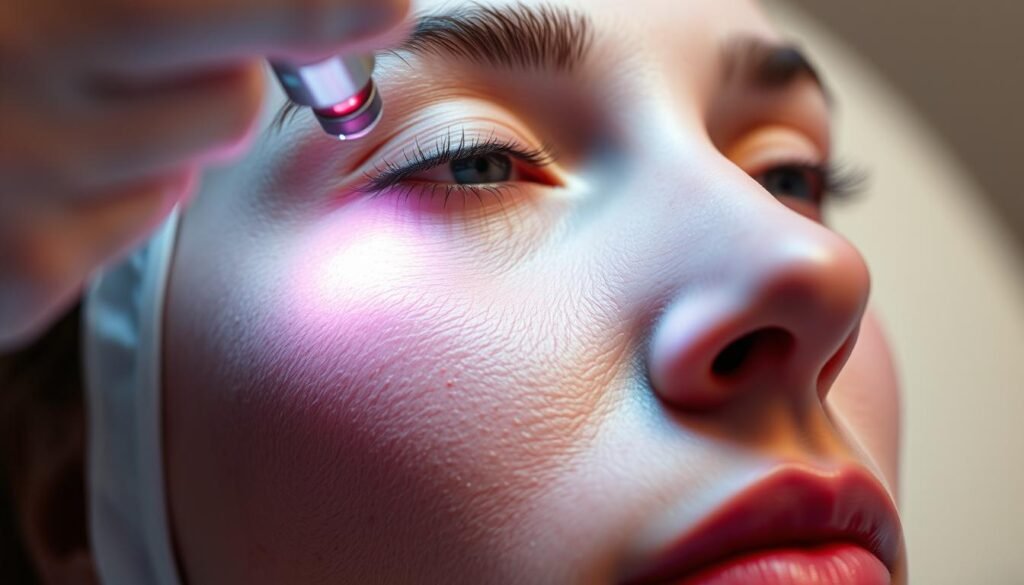Acne scars can be a lasting reminder of past skin struggles, affecting not just our skin but also our confidence. For many, the journey to clear, smooth skin involves exploring various laser treatments designed to address different types of acne scars. With advancements in dermatological technology, laser treatments for acne scars have become a viable option for those seeking to reduce the appearance of scars and improve skin texture.
The quest for effective acne scar treatments involves understanding the different laser technologies available, including ablative and non-ablative lasers, and how they target specific scar types. By examining these options, individuals can make informed decisions about their treatment, potentially leading to significant improvements in their skin’s appearance.
Key Takeaways
- Various laser technologies are available for treating acne scars, including ablative and non-ablative lasers.
- The choice of laser treatment depends on the type and severity of the acne scars.
- Laser treatments can significantly improve skin texture and reduce the appearance of scars.
- Understanding the different laser options is crucial for making informed treatment decisions.
- Individual results may vary based on scar type, skin tone, and other personal factors.
Understanding Acne Scars and Their Impact
Understanding acne scars requires delving into their causes and the profound effects they have on the skin. Acne scars result from the body’s natural response to acne, which can lead to inflammation and, subsequently, scarring.
What Causes Acne Scarring
Acne scarring is primarily caused by the inflammatory response to acne lesions. When acne occurs, it can lead to the rupture of the sebaceous gland, causing inflammation. This inflammation can result in the formation of various types of scars, including depressions, raised areas, and discolorations on the skin. Inflammatory acne, characterized by red, swollen, and painful lesions, is particularly prone to leading to scarring.
“The inflammatory cascade triggered by acne can lead to diverse scar types, making treatment challenging.”
Psychological Effects of Acne Scars
The impact of acne scars extends beyond the physical realm, affecting individuals psychologically. People with visible acne scarring often experience negative self-perception and body image issues. The psychological burden can manifest in various ways, including avoidance of social situations and excessive use of makeup to cover the scars.
- Decreased self-esteem
- Social anxiety
- Reduced quality of life
- Behavioral changes to hide the scars
The severity of these psychological effects doesn’t always correlate with the severity of the scarring, indicating that even mild scarring can have a significant emotional impact. Understanding these effects is crucial for developing treatment plans that address both the physical and emotional aspects of acne scarring.
Types of Acne Scars You Need to Know
There are several types of acne scars, and knowing the differences is key to finding the right treatment. Acne scars can significantly impact an individual’s skin, affecting not only their appearance but also their self-confidence.
Atrophic Scars: Ice Pick, Boxcar, and Rolling Scars
Atrophic scars are characterized by a loss of skin tissue, resulting in depressions or pits in the skin. There are three main types of atrophic scars: ice pick scars, which are narrow and deep; boxcar scars, which have broad, flat bottoms; and rolling scars, which give the skin a wave-like appearance. These scars can be challenging to treat but various laser treatments have shown promising results.
Hypertrophic and Keloid Scars
Unlike atrophic scars, hypertrophic and keloid scars are raised due to an overproduction of collagen during the healing process. Hypertrophic scars remain within the boundaries of the original wound, while keloid scars extend beyond it. These types of scars can be itchy or painful and are more common in individuals with a history of keloid or hypertrophic scarring.
Post-Inflammatory Hyperpigmentation
Post-inflammatory hyperpigmentation (PIH) is not a scar but a temporary discoloration that occurs after inflammation from acne. It appears as flat, darkened patches and is more noticeable in individuals with darker skin tones. PIH can be addressed with laser treatments that target excess melanin, helping to even out the skin tone.
| Type of Scar | Description | Common Treatment |
|---|---|---|
| Atrophic Scars | Depressions or pits in the skin | Laser resurfacing, microneedling |
| Hypertrophic/Keloid Scars | Raised scars due to excess collagen | Steroid injections, laser therapy |
| Post-Inflammatory Hyperpigmentation | Temporary discoloration after acne | Laser treatments targeting melanin |
How Laser Treatments Work for Acne Scars
By harnessing the power of laser energy, dermatologists can effectively treat acne scars and improve skin texture. Laser treatments work by penetrating the skin and targeting the deeper layers where acne scars form.
The Science Behind Laser Therapy
Laser therapy for acne scars involves the use of specific wavelengths of light to stimulate collagen production and promote tissue regeneration. The laser’s absorption properties dictate the depth of penetration and dispersion of thermal energy, which is then dissipated as heat to facilitate tissue remodeling. Er:YAG lasers are particularly effective due to their minimal thermal effects on collagen shrinkage, reducing the risk of pigmentary alterations and scarring.
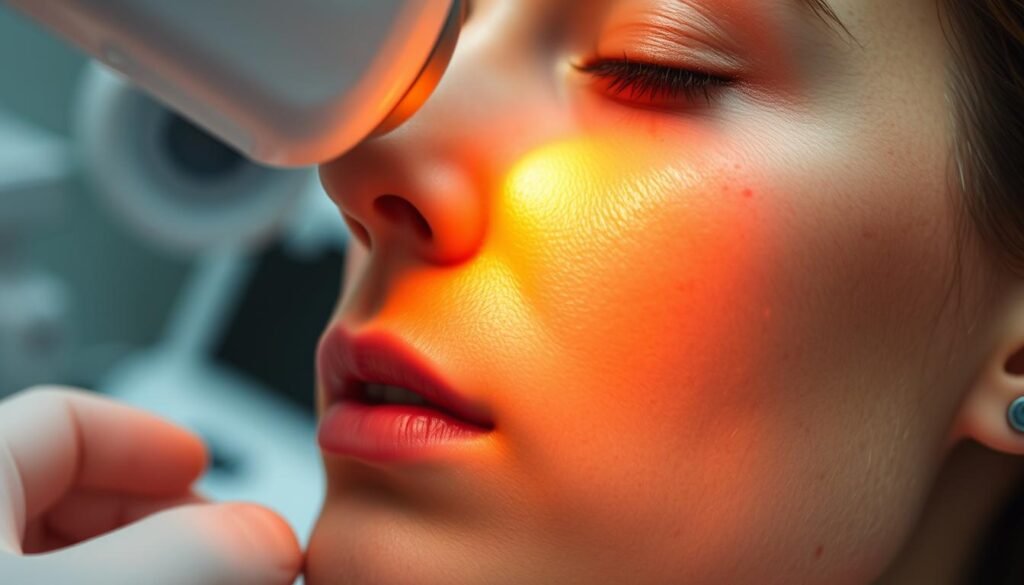
Collagen Remodeling and Tissue Regeneration
The process of collagen remodeling is crucial for improving the appearance of atrophic acne scars. Laser-induced thermal injury triggers a cascade of cellular responses, leading to increased fibroblast activity and new collagen synthesis in the dermis. This results in the elevation of depressed areas and a smoother skin surface. Different laser modalities, such as fractional lasers, affect collagen remodeling in varying ways, preserving surrounding healthy tissue and facilitating faster healing.
| Laser Type | Effect on Collagen | Healing Time |
|---|---|---|
| Er:YAG | Minimal thermal effects, promotes collagen synthesis | Faster healing due to minimal collateral damage |
| CO2 | Significant collagen contraction and remodeling | Longer recovery period |
| Fractional Lasers | Creates microscopic treatment zones, preserving healthy tissue | Reduced downtime |
As indicated by the table, different lasers offer varying benefits in terms of collagen remodeling and healing time. Understanding these differences is key to selecting the most appropriate laser treatment for acne scars.
“Laser treatments represent a significant advancement in the management of acne scars, offering a non-surgical solution with lasting results.”
Best Laser Treatment for Acne Scars: Comprehensive Guide
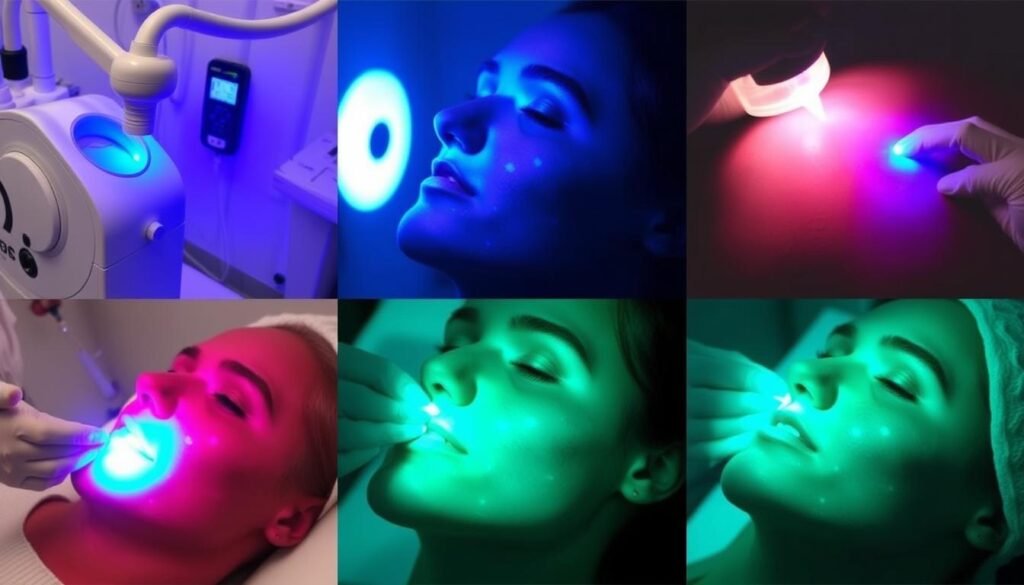
The quest for clear skin has led many to explore laser treatments as a viable solution for acne scars. Laser therapy has revolutionized the treatment of acne scars, offering a range of options tailored to different scar types and skin conditions.
Ablative vs. Non-Ablative Lasers
Ablative lasers remove the top layers of the skin, promoting new collagen production and skin regeneration. While effective, they come with longer recovery times and higher risks of complications. Non-ablative lasers, on the other hand, stimulate collagen production without damaging the skin’s surface, resulting in less downtime but potentially less dramatic results.
Ablative lasers are ideal for deeper scars and more significant skin rejuvenation, whereas non-ablative lasers are better suited for maintaining skin health with minimal recovery.
Fractional vs. Non-Fractional Technology
Fractional laser technology has significantly advanced acne scar treatment by creating microthermal zones, leaving surrounding skin intact for faster healing. This approach has reduced downtime from weeks to days, making it a preferred option for many patients.
- Fractional lasers treat only a fraction of the skin, promoting quicker recovery.
- Non-fractional lasers treat the entire area, potentially offering more consistent results but with longer recovery periods.
- Fractional technology can be applied to both ablative and non-ablative lasers, offering a range of treatment options.
Most modern treatments utilize fractional technology due to its superior safety profile and effectiveness in treating atrophic and hypertrophic scarring, as well as post-inflammatory hyperpigmentation.
CO2 Laser Treatments for Deep Acne Scars
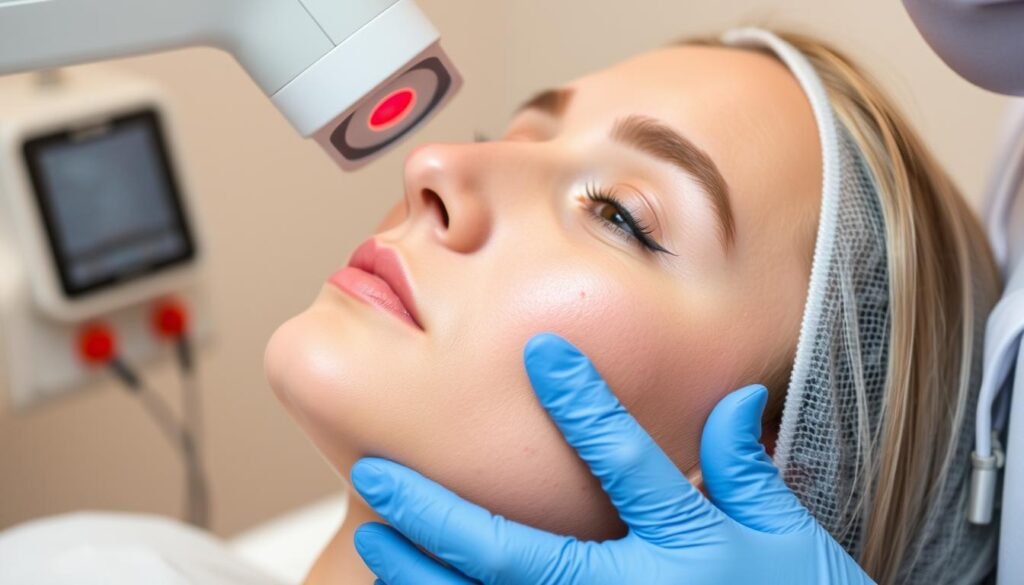
Deep acne scars can be challenging to treat, but CO2 laser treatments have shown significant promise in reducing their appearance. CO2 lasers are a type of ablative laser that vaporizes damaged skin, promoting collagen remodeling and tissue regeneration. This process leads to smoother, healthier-looking skin.
How CO2 Lasers Work
CO2 lasers emit a wavelength that is absorbed by water in the skin, causing the vaporization of damaged skin cells. This process stimulates the production of new collagen, improving skin texture and reducing the appearance of scars. The precision of CO2 lasers allows for targeted treatment, minimizing damage to surrounding healthy skin. For more information on how laser treatments work, visit laser energy treatments.
Effectiveness for Different Scar Types
CO2 laser treatments are particularly effective for deep, atrophic scars, including ice pick and boxcar scars. The treatment can also improve the appearance of rolling scars by promoting collagen remodeling. However, the effectiveness of CO2 lasers can vary depending on the individual’s skin type and the severity of the scarring. It’s essential to consult with a dermatologist to determine the best course of treatment.
Recovery and Downtime
Recovery from CO2 laser treatment typically involves 7-14 days of significant downtime. The first 24-48 hours are characterized by intense redness, swelling, and weeping of the treated areas. Proper wound care is crucial during this period to prevent infection and promote healing. Most patients can resume normal activities and apply makeup after 7-10 days, though residual redness may persist. Complete sun avoidance is mandatory during the healing phase, followed by rigorous sun protection for at least 3-6 months to prevent post-inflammatory hyperpigmentation.
Erbium YAG Laser: Gentler Alternative with Effective Results
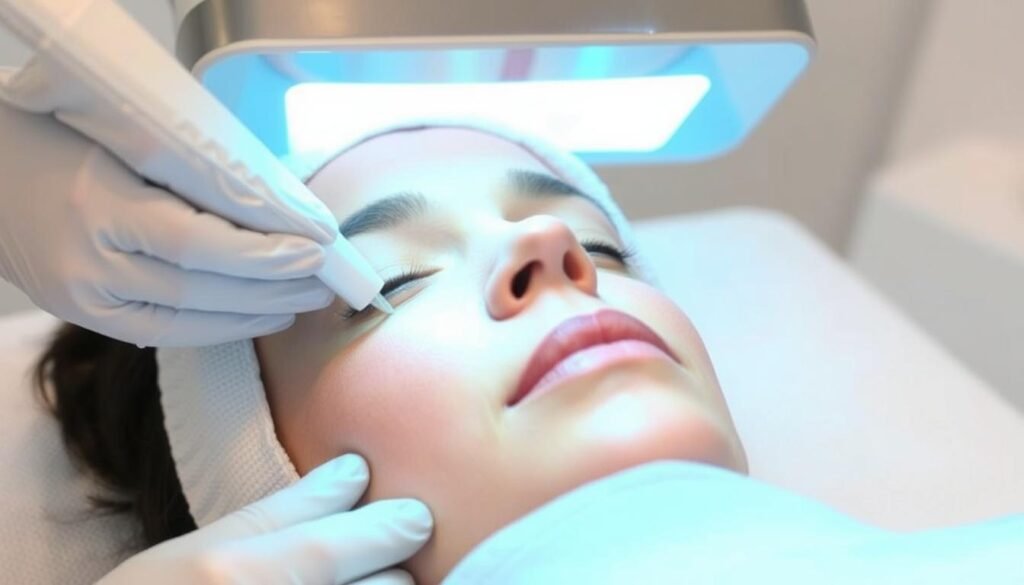
Erbium YAG laser therapy offers a promising approach to addressing acne scars with minimal downtime. This treatment modality is particularly appealing to individuals seeking to mitigate the appearance of scars without undergoing extensive recovery periods.
Mechanism of Action
The Erbium YAG laser works by ablating the skin’s surface, promoting collagen remodeling, and thereby improving the texture and appearance of the skin. This process involves the selective absorption of laser energy by water in the skin, leading to the removal of damaged skin layers and the stimulation of new collagen production.
Ideal Candidates and Scar Types
Individuals with mild to moderate acne scars, particularly those with atrophic scars, are ideal candidates for Erbium YAG laser treatment. The effectiveness of the treatment can vary based on the scar type and individual skin characteristics. For more information on skin rejuvenation treatments, including Erbium YAG laser, patients can consult with a dermatological professional.
Side Effects and Recovery
Common side effects of Erbium YAG laser treatment include temporary redness, swelling, and mild peeling. The recovery period typically lasts between 5 to 7 days, significantly shorter than that associated with traditional CO2 laser resurfacing. Patients are advised to follow post-treatment care instructions to minimize potential complications and enhance healing.
Fraxel Dual Laser: Popular Option for Moderate Scarring

Moderate acne scarring can be effectively addressed with the Fraxel Dual Laser, a technology that has gained significant attention in dermatological treatments. This non-ablative, fractionated laser system is designed to stimulate collagen production and promote skin renewal, leading to improved texture and reduced appearance of scars.
How Fraxel Works for Acne Scars
The Fraxel Dual Laser treats only a fraction of the skin at a time, creating microthermal zones that stimulate the body’s natural healing process. This fractionated approach allows for faster recovery and reduces the risk of complications. By targeting specific areas, the laser promotes collagen remodeling and tissue regeneration, which are crucial for improving the appearance of acne scars.
Expected Results and Timeline
Patients typically require 3-5 treatment sessions, spaced about a month apart, to achieve optimal results. The Fraxel Dual Laser’s dual wavelength technology allows it to address both texture and pigmentation issues simultaneously, often providing better value than separate treatments. Most patients start noticing improvements after the first session, with continued enhancement over the treatment period.
Cost and Treatment Sessions
The cost of Fraxel Dual treatments for acne scarring typically ranges from $800 to $1,800 per session in the United States. Total treatment packages can average between $2,400 and $7,500 for a series of 3-5 sessions. Geographic location and the severity of scarring can influence the overall cost and number of sessions required. While few insurance plans cover Fraxel treatments as they’re considered cosmetic, many providers offer financing options or package discounts.
Clear + Brilliant and LaseMD: Gentle Laser Options
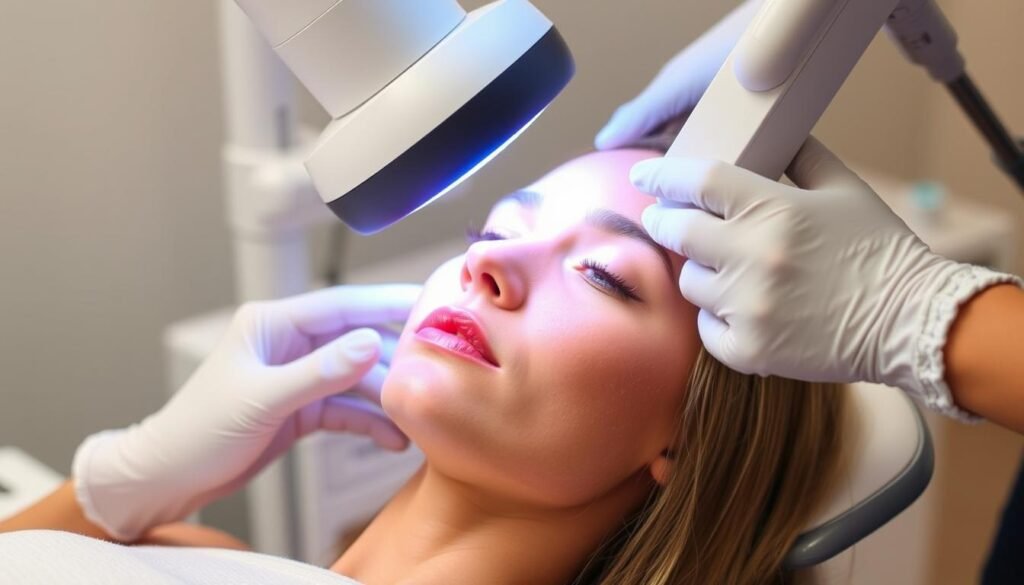
For those with mild to moderate acne scarring, Clear + Brilliant and LaseMD offer gentle yet effective laser treatments. These options are particularly appealing to individuals who cannot afford significant downtime due to their busy lifestyles.
Benefits for Mild to Moderate Scarring
The Clear + Brilliant and LaseMD lasers are designed to stimulate collagen production and promote skin renewal, making them ideal for addressing mild to moderate acne scarring. By using fractional laser technology, these treatments create micro-injuries that trigger the body’s natural healing process, leading to smoother and more even-toned skin over time.
Patients typically require a series of treatments, usually 4-6 sessions spaced 2-4 weeks apart, to achieve noticeable improvements in their acne scars. This gradual approach not only minimizes downtime but also allows for more subtle and natural-looking results.
Minimal Downtime Advantages
One of the primary advantages of Clear + Brilliant and LaseMD treatments is their minimal downtime. Most patients experience only 12-24 hours of mild redness followed by 2-3 days of subtle skin roughness. This “lunchtime procedure” profile makes it possible for individuals to maintain their normal social and professional activities without interruption.
The gentle nature of these lasers also reduces the risk of post-inflammatory hyperpigmentation, making them safer options for patients with darker skin tones. Furthermore, the comfortable treatment experience, often described as a mild prickling or warming sensation, typically requires only topical numbing, eliminating the need for sedation or pain management protocols.
Picosecond Lasers: PicoSure and PicoWay for Pigmentation
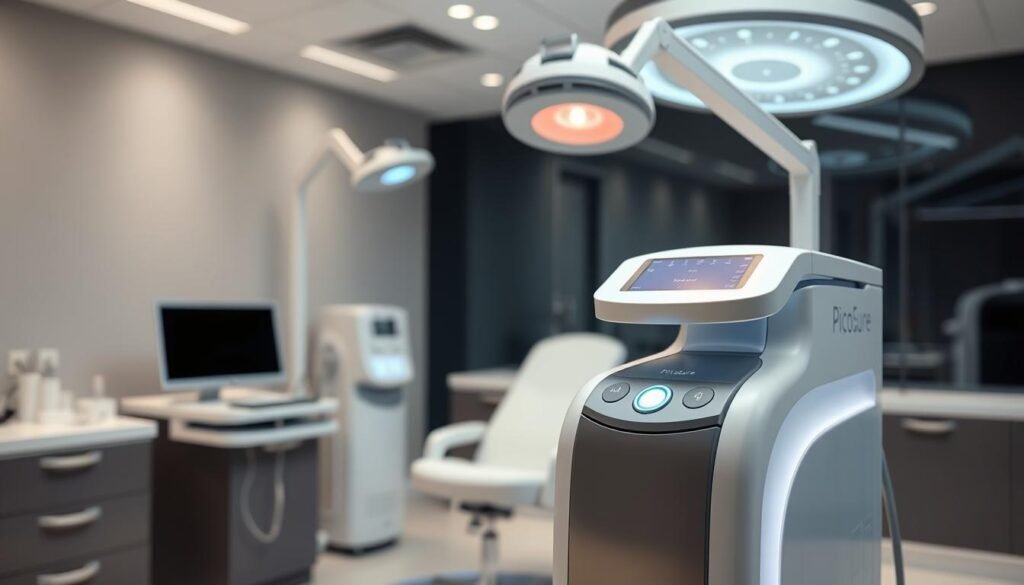
The advent of picosecond lasers, such as PicoSure and PicoWay, has marked a significant advancement in treating post-inflammatory hyperpigmentation associated with acne scarring. These lasers have shown remarkable efficacy in addressing both the discoloration and textural irregularities that often accompany acne scars.
Technology and Mechanism
Picosecond lasers operate by delivering ultra-short pulses of energy to the skin, targeting pigmented lesions and stimulating collagen production. This technology allows for more effective clearance of pigmentary issues with fewer treatments compared to traditional lasers.
The mechanism involves the selective photothermolysis of pigmented cells, leading to their removal and subsequent skin brightening. Additionally, the stimulation of collagen remodeling helps in improving skin texture.
Effectiveness for Pigmentation and Textural Issues
Clinical studies have demonstrated that picosecond lasers excel at treating post-inflammatory hyperpigmentation, with 70-80% clearance of pigmentary issues after 2-4 treatments. They are particularly beneficial for patients with darker skin tones, showing superior efficacy and reduced risk of paradoxical hyperpigmentation.
Moreover, when used with specialized lens arrays, these lasers can improve mild to moderate atrophic acne scarring by approximately 25-40% through collagen stimulation. While the results for textural improvements are less dramatic than those achieved with ablative lasers, the combination of pigmentary correction and textural enhancement makes picosecond lasers a valuable treatment option.
Results for pigmentation can be observed relatively quickly, often within 2-3 weeks after treatment, whereas textural improvements develop more gradually over 2-3 months as collagen remodeling occurs. This dual benefit makes picosecond lasers particularly valuable for patients concerned with both discoloration and mild scarring.
Vascular Lasers: Vbeam and Excel V for Red Scars
Vascular lasers represent a significant advancement in the treatment of redness associated with acne scars. These lasers are particularly effective for patients with red or purple discoloration.
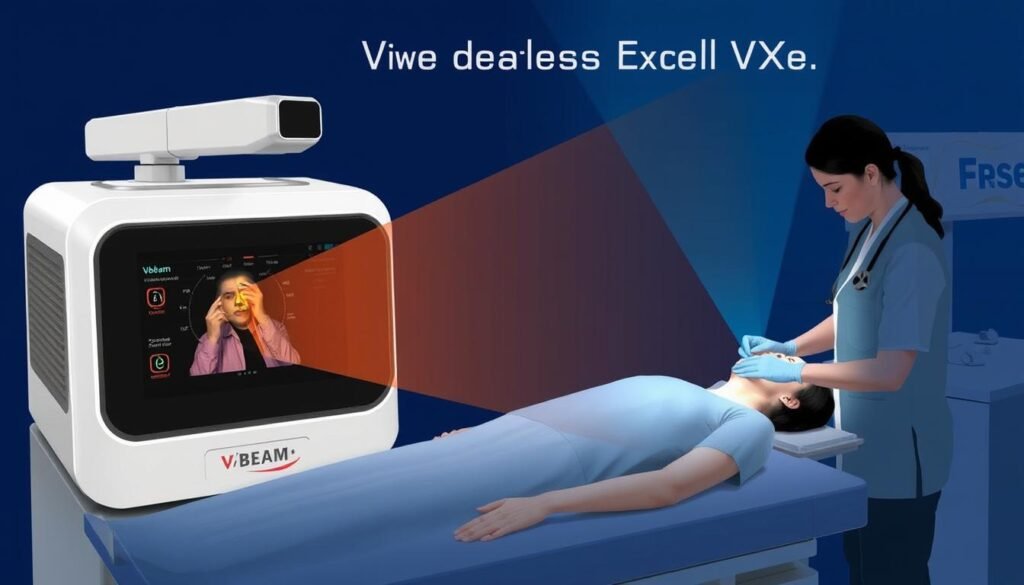
How They Target Redness in Scars
Vascular lasers, such as Vbeam and Excel V, specifically target the vascular components of acne scars, reducing redness and promoting a more even skin tone. The technology behind these lasers involves emitting wavelengths that are absorbed by hemoglobin, thereby reducing the appearance of redness.
The effectiveness of vascular lasers for red acne scars lies in their ability to selectively target and reduce the vascular structures without damaging the surrounding skin.
Combining with Other Treatments
For optimal outcomes, vascular lasers are often combined with other treatments. The sequential approach of first using vascular lasers to address redness, followed by fractional resurfacing to improve texture, has been shown to yield superior results. Additionally, combining vascular lasers with injectable treatments like corticosteroids or fillers can address multiple aspects of scarring simultaneously, including redness, texture, and pigmentation.
Key benefits include:
- Vascular lasers are frequently used as the first step in comprehensive acne scar treatment protocols.
- The sequential approach yields superior outcomes compared to using either treatment alone.
- Combining vascular lasers with other modalities allows for addressing multiple scar types simultaneously.
- Minimal downtime (typically 1-3 days of mild redness or purpura) makes them easy to incorporate into treatment plans.
Choosing the Right Laser Treatment for Your Skin Type
The success of laser therapy for acne scars hinges on selecting a treatment that is compatible with your skin type and tone. Different laser technologies are suited for various skin characteristics, and understanding these differences is key to achieving optimal results.
When considering laser treatment for acne scars, it’s essential to consult with a professional who can assess your skin and recommend the most appropriate laser technology. This personalized approach helps in minimizing potential side effects and maximizing the efficacy of the treatment.
Considerations for Darker Skin Tones
Individuals with darker skin tones face unique challenges when it comes to laser treatments. As noted by experts, “Because of this, patients with darker skin tones are candidates for non-ablative lasers, as they do not induce the abnormal pigmentation that often arises with ablative laser use on darker skin.” Non-ablative lasers are preferred because they offer a safer alternative with fewer risks of adverse effects.
The lack of heat in certain laser technologies makes them more suitable for darker skin tones, reducing the risk of variable outcomes and unpredictable results associated with heat-based treatments. This consideration is crucial for ensuring the safety and effectiveness of laser treatments for acne scars in diverse populations.
Matching Laser Types to Scar Types
Different types of acne scars respond better to specific laser technologies. For instance, deep ice pick scars typically respond best to ablative fractional CO2 lasers or combination approaches. Boxcar scars with well-defined edges show excellent improvement with both ablative and non-ablative fractional lasers, depending on scar depth and patient tolerance for downtime.
- Deep ice pick scars are effectively treated with ablative fractional CO2 lasers or TCA CROSS prior to laser resurfacing.
- Boxcar scars respond well to both ablative (CO2, Er:YAG) and non-ablative fractional lasers (1540nm, 1550nm).
- Rolling scars often require a multi-modal approach, including subcision followed by fractional laser resurfacing.
- Post-inflammatory erythema is best addressed with vascular-specific lasers like pulsed dye (Vbeam) or KTP/Nd:YAG (Excel V).
- Post-inflammatory hyperpigmentation is effectively treated with picosecond lasers, 1927nm thulium lasers, or Q-switched lasers that target melanin.
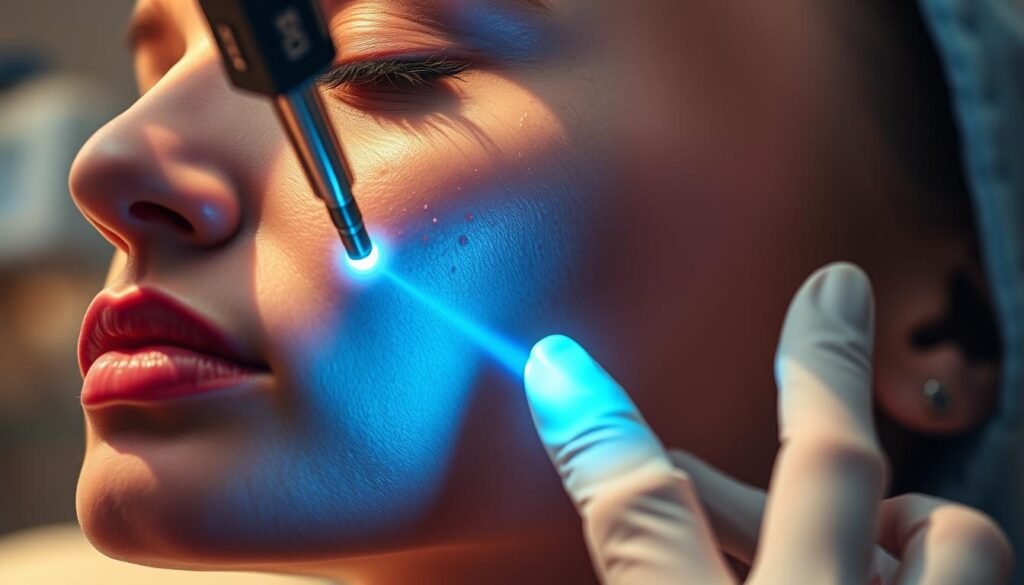
Comparing Laser Treatments to Other Acne Scar Therapies
Laser treatments are just one of several approaches to addressing acne scars; other therapies include microneedling, chemical peels, and dermal fillers. Understanding the benefits and limitations of each treatment is crucial for determining the best course of action.
Microneedling and RF Microneedling
Microneedling involves creating micro-injuries in the skin to stimulate collagen production, improving the appearance of acne scars. RF microneedling combines this technique with radiofrequency energy for enhanced collagen remodeling. This treatment is particularly effective for atrophic acne scars and can be used on various skin types.
Chemical Peels and Dermabrasion
Chemical peels involve applying a solution to remove the top layers of the skin, reducing the appearance of acne scars. Dermabrasion is a more invasive procedure that uses a special tool to gently sand away the top layers of skin. Both treatments can be effective but may require multiple sessions and have varying downtime.
Dermal Fillers for Acne Scars
Dermal fillers, such as hyaluronic acid or calcium hydroxylapatite, are injected beneath the scar to lift the depressed area, providing immediate results. They are particularly useful for deep atrophic scars and offer a temporary solution that can be repeated as needed.
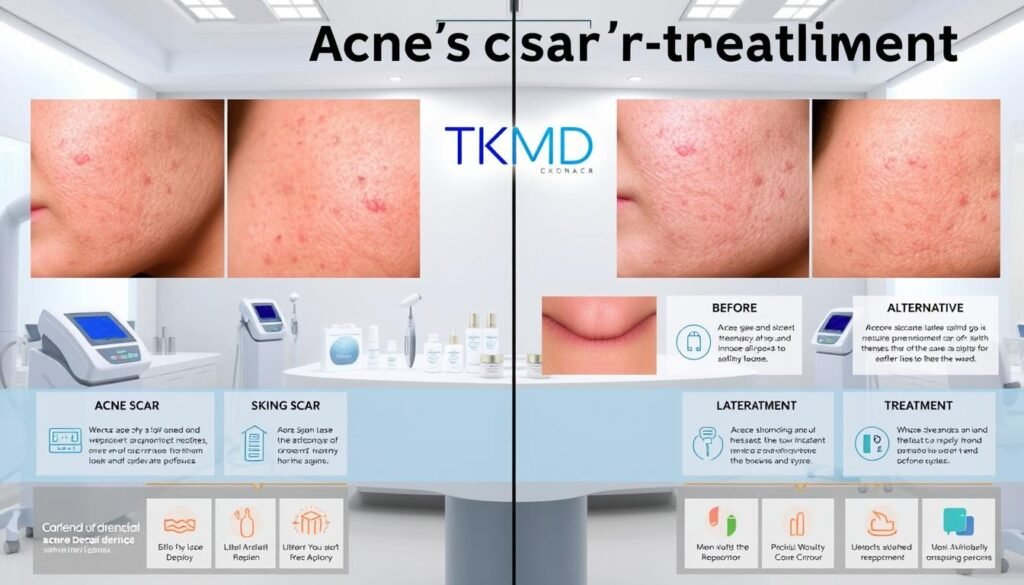
| Treatment | Effectiveness | Downtime |
|---|---|---|
| Laser Treatments | High for various scar types | Variable, can be several days to weeks |
| Microneedling | Effective for atrophic scars | Minimal, typically 1-3 days |
| Chemical Peels | Moderate, depends on peel depth | Variable, can be several days to a week |
| Dermal Fillers | Immediate for deep scars | Minimal, typically 1-2 days |
Combination Approaches for Optimal Results
Combining laser treatments with other therapies can lead to significantly improved outcomes for acne scars. This approach allows for a more comprehensive treatment plan that addresses different aspects of scarring.
Laser Plus PRP Therapy
PRP therapy uses the patient’s blood to harness growth factors and stimulate natural skin repair processes, making it a cutting-edge treatment for acne scars. When combined with laser treatments, PRP can accelerate the healing process and enhance results. The process involves drawing blood from the patient, spinning it in a centrifuge to separate platelets, and then applying the concentrated platelet-rich plasma topically after laser treatment or microneedling.
Multi-Modal Treatment Plans
Comprehensive acne scar treatment often requires a multi-modal approach that addresses different aspects of scarring through a strategic combination of complementary procedures. Common combination protocols include subcision for fibrous rolling scars, followed by fractional laser resurfacing to stimulate collagen, and finally vascular lasers to address any residual redness. For patients with mixed scar types, treatment plans might incorporate TCA CROSS for ice pick scars, fractional lasers for boxcar and rolling scars, and fillers for any remaining deep depressions.
Post-Treatment Care and Recovery
Laser treatment for acne scars is just the first step; proper aftercare is essential for achieving the best outcomes. According to Dr. Rogers, “I like patients to prep their skin for at least a month before a laser treatment for acne scars.” This preparation is crucial, and it continues after the treatment.
Managing Side Effects
After laser treatment, the skin may experience side effects such as redness, swelling, or sensitivity. To manage these effects, it’s crucial to follow a gentle skincare routine. “During the first 7-10 days after treatment, patients should use only prescribed or recommended products,” says Dr. Rogers. This typically includes a gentle non-foaming cleanser, medical-grade healing ointment or barrier repair cream, and physical sunblock with SPF 30+.
Using these products helps to minimize potential complications and support the healing process. It’s also important to avoid direct sun exposure and use rigorous sun protection to prevent further damage.
Skincare Routine After Laser Treatment
As the skin heals, typically after 1-2 weeks, patients can gradually reintroduce basic skincare products. It’s essential to avoid active ingredients like retinoids, alpha hydroxy acids, vitamin C, and exfoliants until cleared by their provider.
- Gentle cleansing to avoid irritating the skin
- Intensive hydration to support skin health
- Rigorous sun protection to prevent hyperpigmentation
Long-term post-laser skincare should emphasize daily broad-spectrum sun protection, antioxidants, and eventually retinoids to maintain collagen production and prevent new acne formation. By following these guidelines, patients can ensure optimal healing and achieve the best possible results from their laser treatment.
Cost Considerations and Insurance Coverage
The cost of laser treatments for acne scars can vary significantly based on several factors, including the type of laser used, the severity of the scarring, and the number of sessions required.
Average Price Ranges for Different Laser Treatments
The average cost for laser treatments can range widely. For instance, ablative laser treatments tend to be more expensive than non-ablative treatments due to their higher efficacy for deeper scars. Patients can expect to pay varying prices depending on their location and the expertise of the practitioner.
- Costs can vary from $500 to $2,000 per session, with most patients requiring multiple sessions.
- The total cost is influenced by factors such as the technology used and the practitioner’s fees.
Financing Options and Payment Plans
To make laser treatments more accessible, many aesthetic medical practices offer financing options and payment plans. These can include in-house financing, third-party medical financing companies, and package discounts for multiple sessions.
- Patients can explore options like CareCredit, Alphaeon Credit, and PatientFi for financing.
- Some practices offer membership programs that provide discounted rates on various treatments, including laser procedures.
By understanding the costs and exploring financing options, patients can make informed decisions about their laser treatment plans, ultimately achieving better overall skin and improved outcomes.
Conclusion: Making an Informed Decision
The journey to smoother skin begins with understanding the various laser treatments available for acne scars. Selecting the optimal laser treatment requires careful consideration of multiple factors, including scar type, skin tone, budget constraints, tolerance for downtime, and realistic outcome expectations.
Consulting with a board-certified dermatologist or plastic surgeon who specializes in laser treatments is essential. Their expertise in assessing your specific scarring pattern will guide the most appropriate treatment selection. For patients with deeper atrophic scars seeking dramatic improvement, ablative fractional CO2 or Er:YAG lasers typically provide the most substantial results.
Those with moderate scarring may achieve excellent outcomes with non-ablative fractional lasers like Fraxel Dual. Patients with mild scarring or those concerned with pigmentation may benefit from gentler options like Clear + Brilliant or picosecond lasers. The most successful acne scar treatment plans often incorporate a strategic combination of complementary procedures tailored to individual skin characteristics and personal preferences.
By understanding the available laser treatments and consulting with a professional, individuals can make informed decisions to achieve comprehensive improvement in both skin texture and overall skin appearance.

